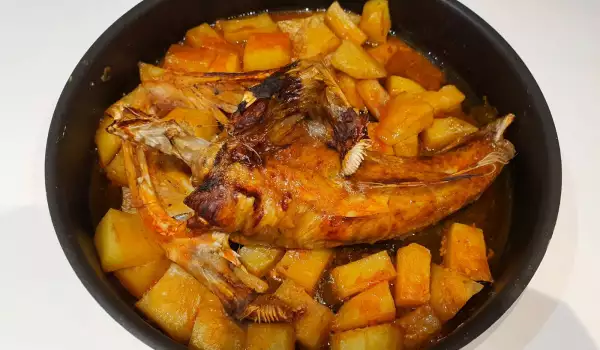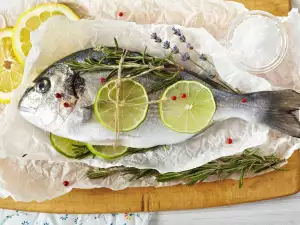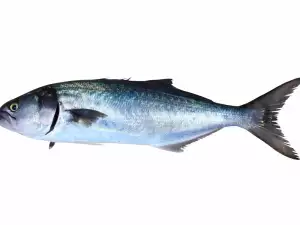The depths of the sea hide monsters unknown to man and sea creatures that surpass legends and myths and seem to have come out of horror movies. Such wonderful sea creature is the monkfish, which became the prototype of the monster from Finding Nemo.
General information about monkfish
All kinds of creatures have appeared on Earth in the process of evolution. In the harsh conditions of the sea, at a great depth, where the water is ice cold, the pressure reaches colossal values. There, the amount of food is minimal. Such living conditions attract very few sea creatures.
This space is home to deep-sea marine creatures of the genus Cetatioidei, such as the monkfish. At a depth of 1.5 to 3 kilometers, they feel good. A peculiarity of the deep-sea fish is the modified ray of the dorsal fin, which acts as a bait and in its shape resembles the fisherman's fishing rod. For this reason, the fish is often called an angler.
At the end of the fishing rod-like modified fin, hanging above the huge mouth with sharp needle-like teeth, is a small growth of skin filled with millions of glowing bacteria. This light is especially valuable where impenetrable darkness reigns. It attracts all the other sea creatures that swim around, like a moth is attracted to a candle flame. The angler is able to control the brightness and frequency of the light to improve the effect of the light it emits, that is, it can extinguish or ignite the glowing bacteria by means of a muscle. Hidden on the bottom or among thick algae, the monkfish stalks its prey and devours it in a flash as soon as it enters its perimeter.
The monkfish can swallow prey as big as itself and sometimes more massive than itself. It attacks not only fish and crustaceans, but sometimes birds when it jumps out of the water during the spawning period. For human life, this fish is not dangerous, because it reaches 1.5 meters and 20 kilograms of weight, but it can seriously injure a diver or fisherman. It is an absolute predator, attacking anything that moves. The enemies of the monkfish at a great depth are not many, the fish is afraid only of sharks, octopuses and other sea giants capable of dealing with it.
A very interesting point in catching these fish is that the specimens caught are half used and are usually female. This does not mean that males are more adaptable and hide better than trawls, but another interesting feature of the fish. When they reach a size of only 4 centimeters, the males attach their teeth to the female and begin to grow together with her, losing their independence of separate organisms and becoming a second specimen in the partner's body. The purpose of this transformation is to provide sperm for fertilization of the female at the right time, so she is not looking for a mate when the spawning period arrives. When a fish is purchased at the market, it is quite possible that the purchased fish will bring a few more with it. What else will a seafood shopper get with the purchase of a monkfish?
Features and beneficial properties of monkfish meat

Monkfish are a genus of benthic fish, numbering 12 species, but several of them are edible. The black-bellied monkfish, which inhabits the Atlantic from Ireland to North Africa and is also found in the Mediterranean, is an object of fishing. The European subspecies, which lives in the waters north of the continent, is also edible. The American monkfish is also of culinary interest and is found all along the west coast of North America. In the Pacific waters from Kamchatka to Japan, another species of monkfish with worthy culinary qualities can be caught. In fact, all types represent an expensive culinary delicacy and are a real gastronomic miracle.
When marketed, this fish is often frozen and found in fish fillets. The meat is low in fat and quickly loses moisture and flavor when frozen, so fresh or chilled fish is recommended.
The meat of the monkfish is white, pleasant, rich in vitamins A and D, contains many minerals, proteins and amino acids and very little fat, which makes it dietary. It can be included in the diet of people who want to control their weight, as well as those suffering from atherosclerosis and diabetes.
The vitamin complex, along with magnesium, iodine, phosphorus and iron in fish meat helps with diseases of the endocrine system, the heart and blood vessels.
The boneless white meat is a good source of protein and trace elements for pregnant women and children, the elderly, and active people.
Taste qualities of monkfish meat

Although after the catch, half of the fish goes to waste and only the tail remains for consumption, the result is excellent. The meat is very light, with small pink stripes, it has a pleasant taste and slightly noticeable sweetness.
During cooking, the meat thickens and in order for it not to dry out, it is good that the culinary processing of the fish is short.
Not only the meat is eaten, but also [the roe of the fish, and in Eastern cuisine the liver and fins are also subject to culinary experiments.
Ways of preparing monkfish in different national cuisines.
A kind of division can be made in terms of cuisine in separate geographical regions, which shows interesting trends.
Monkfish in European Cuisine

Monkfish is best served fried, in nutritious fish soups and broths, much liked in French cuisine. The fins and heads are added to them. The liver is marinated and made into fish pate in France and Spain. The fish is served as fancy fried medallions with carrots, berry sauce, roasted potatoes or asparagus.
The European range of cooking options also includes a flavored white fillet, which is served fried with a cheese crust enriched with the aroma of rosemary and a cream-textured oven-baked vegetable sauce.
This low-fat fish is baked rolled up with a filling of spicy herbs, tomato and lemon peel.
In Mediterranean cuisine the fish is boiled and stewed. It is added in fish soups and risotto with fish.
In North Africa and Sicily, it is added to couscous.
Monkfish in Oriental Cuisine
In the East, fish is highly valued. In Japan, not only the meat, but also the skin, fins and even the stomach of the monkfish are used for culinary purposes.
In China, quick meals are prepared with it. The meat is lightly fried in a wok and soy sauce, coriander and ginger are added. Steamed bamboo, rice and onions are a side dish to the fish.
In Korea they make a rich sweet monkfish soup with vegetables and other saltwater fish. A filling for rice pancakes is also made with it.
Monkfish in American Cuisine
In America, this fish is usually grilled. They do not use the fillets of the fish, but pieces of meat on the bone and this makes the meat very juicy, cooked with olive oil and salt. The resulting fish cutlet is served with stewed brandy or mashed potatoes.
This large, ugly-looking flat fish is tasty and healthy and can be consumed by people with health problems or who are overweight. Interesting recipes are grilled monkfish, sushi with fish, monkfish skin chips, monkfish with mussels, with capers, as well as prepared in Spanish-style and many other amazing offers from the master chefs.












Comments